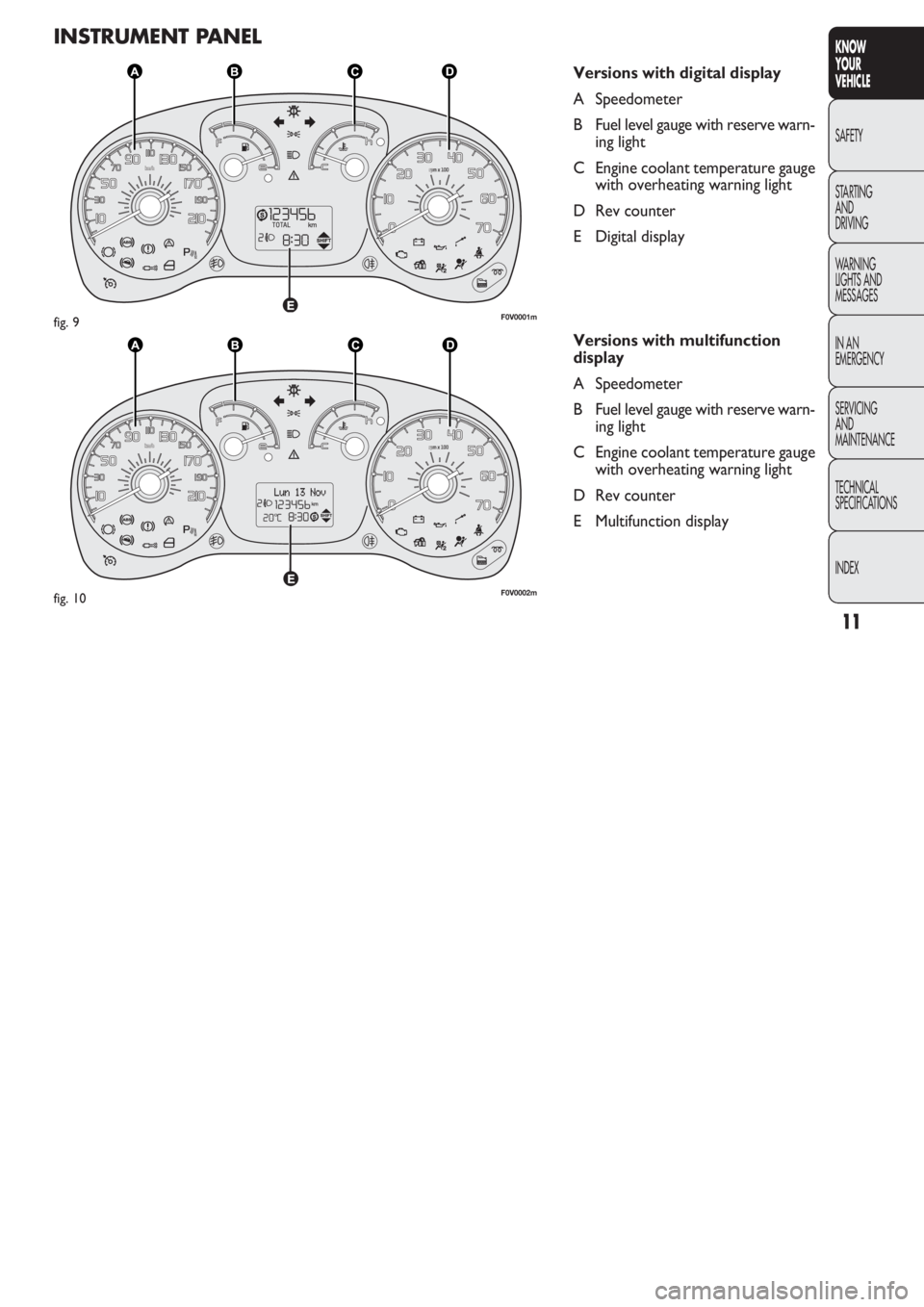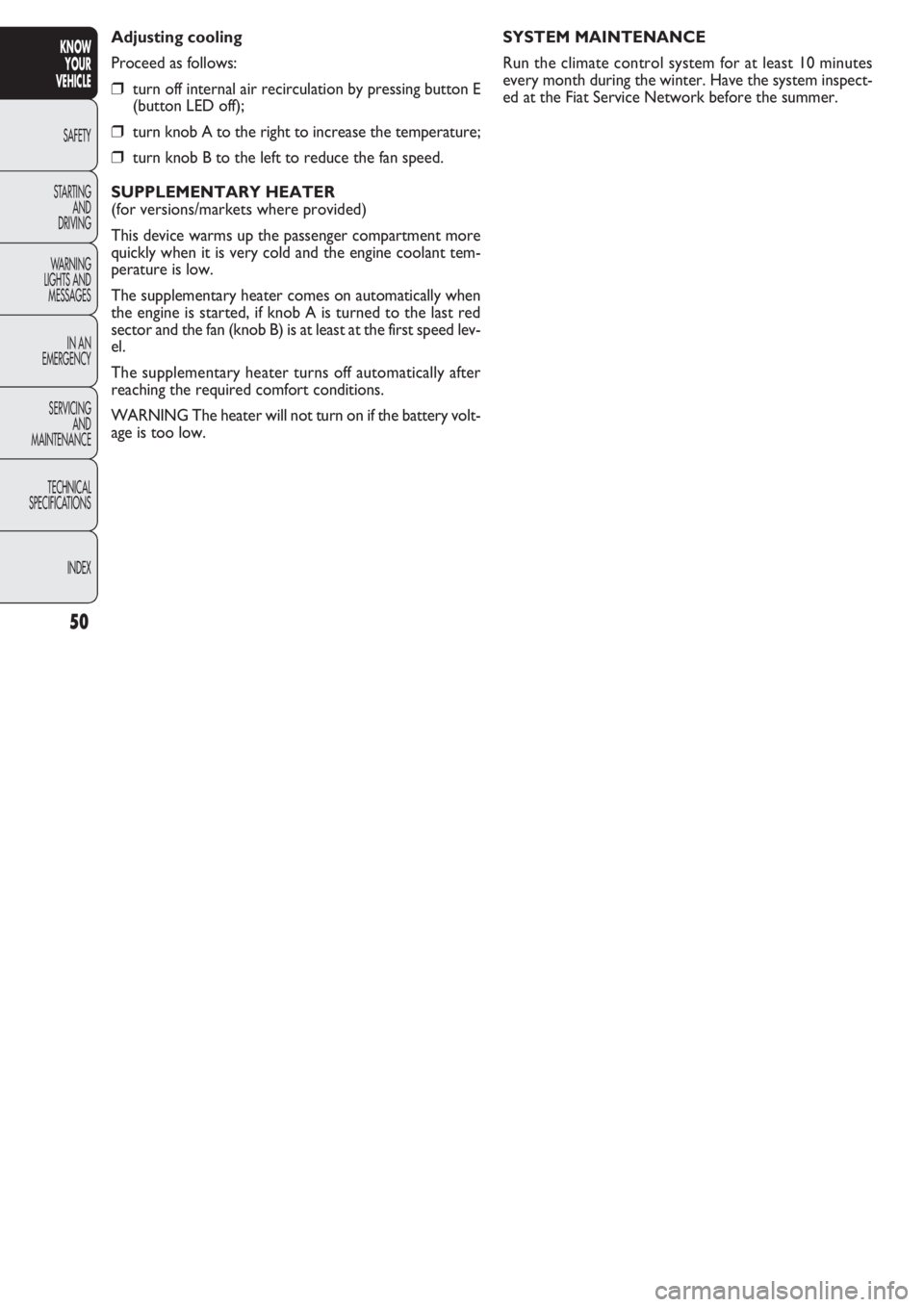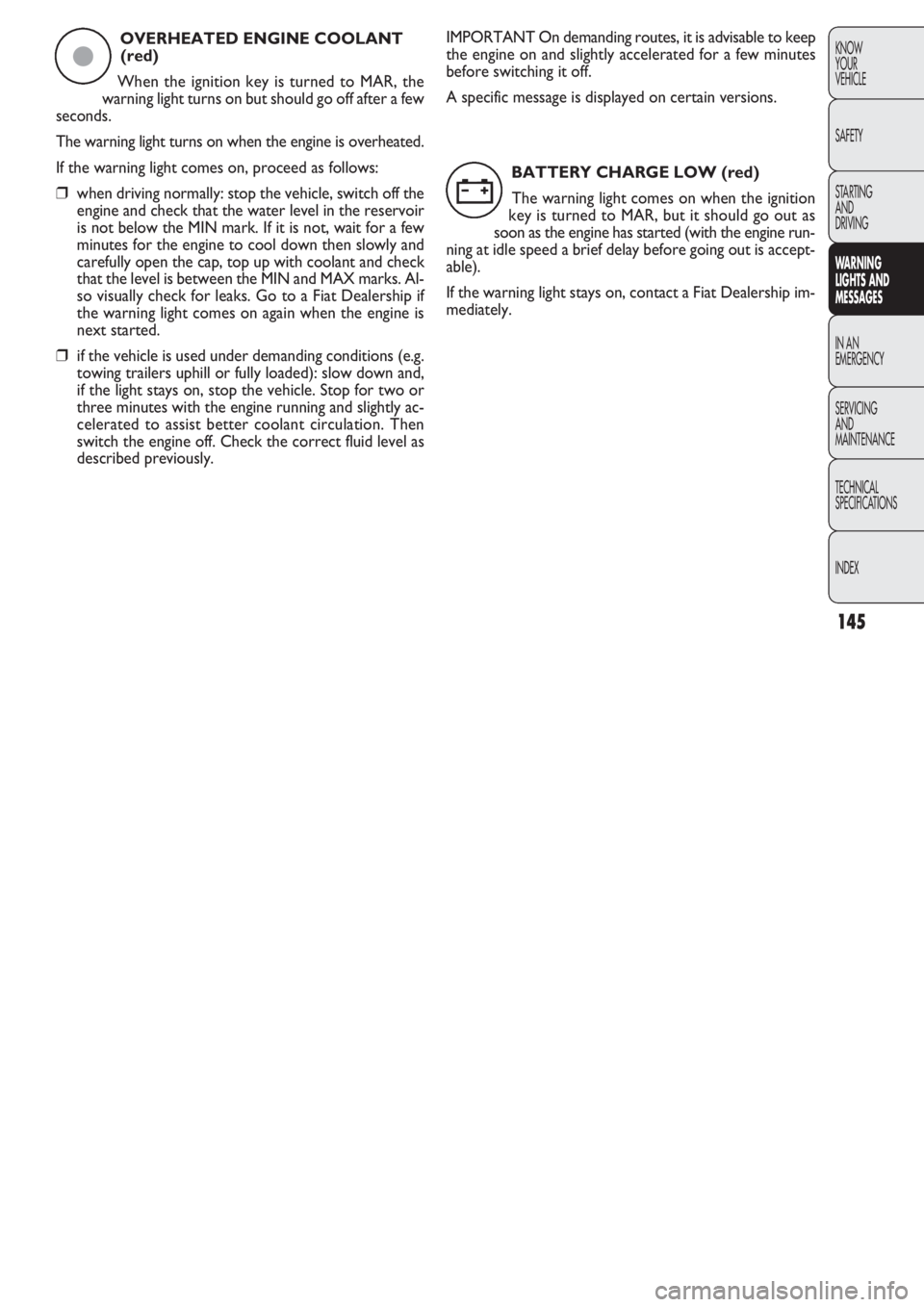engine coolant FIAT DOBLO COMBI 2011 Owner handbook (in English)
[x] Cancel search | Manufacturer: FIAT, Model Year: 2011, Model line: DOBLO COMBI, Model: FIAT DOBLO COMBI 2011Pages: 274, PDF Size: 5.96 MB
Page 12 of 274

11
KNOW
YOUR
VEHICLE
SAFETY
STAR
TING
AND
DRIVING
WARNING
LIGHTS AND
MESSAGES
IN AN
EMERGENCY
SERVICING
AND
MAINTENANCE
TECHNICAL
SPECIFICATIONS
INDEX
INSTRUMENT PANEL
Versions with digital display
A Speedometer
B Fuel level gauge with reserve warn-
ing light
C Engine coolant temperature gauge
with overheating warning light
D Rev counter
E Digital display
Versions with multifunction
display
A Speedometer
B Fuel level gauge with reserve warn-
ing light
C Engine coolant temperature gauge
with overheating warning light
D Rev counter
E Multifunction display
F0V0001mfig. 9
F0V0002mfig. 10
Page 14 of 274

13
KNOW
YOUR
VEHICLE
SAFETY
STAR
TING
AND
DRIVING
WARNING
LIGHTS AND
MESSAGES
IN AN
EMERGENCY
SERVICING
AND
MAINTENANCE
TECHNICAL
SPECIFICATIONS
INDEX
F0V0009mfig. 13
ENGINE COOLANT TEMPERATURE
GAUGE fig. 13
This shows the temperature of the engine coolant and
starts working when the fluid temperature exceeds ap-
prox. 50 °C.
In normal usage, the needle should hover around the mid-
dle of the scale.
C Low engine coolant temperature.
H High engine coolant temperature.
Warning light B may light up (and a message on the multi-
function display may appear on certain versions) to indicate
that the coolant temperature is too high; in this case, stop
the engine and contact the Fiat Service Network. FUEL LEVEL GAUGE fig. 13
This shows the amount of fuel left in the tank.
E tank empty.
F tank full (see “Refuelling”).
Warning light A comes on to indicate that approximately
8-10 litres of fuel are left in the tank.
Do not travel with the fuel tank almost empty: the gaps
in fuel delivery could damage the catalytic converter.
WARNING The needle will point to E and warning light
A will flash to indicate a fault in the system. If this is the
case, go to the Fiat Service Network to have the system
checked.
If the needle enters the red zone, switch off
the engine immediately and contact the
Fiat Service Network.
Page 51 of 274

50
KNOW
YOUR
VEHICLE
SAFETY
STAR
TING
AND
DRIVING
WARNING
LIGHTS AND
MESSAGES
IN AN
EMERGENCY
SERVICING
AND
MAINTENANCE
TECHNICAL
SPECIFICATIONS
INDEX
SYSTEM MAINTENANCE
Run the climate control system for at least 10 minutes
every month during the winter. Have the system inspect-
ed at the Fiat Service Network before the summer. Adjusting cooling
Proceed as follows:
❒turn off internal air recirculation by pressing button E
(button LED off);
❒turn knob A to the right to increase the temperature;
❒turn knob B to the left to reduce the fan speed.
SUPPLEMENTARY HEATER
(for versions/markets where provided)
This device warms up the passenger compartment more
quickly when it is very cold and the engine coolant tem-
perature is low.
The supplementary heater comes on automatically when
the engine is started, if knob A is turned to the last red
sector and the fan (knob B) is at least at the first speed lev-
el.
The supplementary heater turns off automatically after
reaching the required comfort conditions.
WARNING The heater will not turn on if the battery volt-
age is too low.
Page 58 of 274

57
KNOW
YOUR
VEHICLE
SAFETY
STAR
TING
AND
DRIVING
WARNING
LIGHTS AND
MESSAGES
IN AN
EMERGENCY
SERVICING
AND
MAINTENANCE
TECHNICAL
SPECIFICATIONS
INDEX
❒the maximum air temperature for the HI air is set in
both areas;
❒sets the fan speed set according to the engine coolant
temperature to limit the flow of air that is insufficiently
warm to demist the windows;
❒the air flow is directed to the windscreen and front
door window glasses diffusers;
❒switches on the heated rear windscreen
WARNING The rapid demisting/defrosting function for
the windows remains on for about 3 minutes from when
the engine coolant reaches the appropriate temperature
for a rapid demisting of the windows.
When this function is active, the LED in the correspond-
ing button and the one for the heated rear windscreen but-
ton switch on. The message FULL AUTO goes off on the
display.
You can only adjust the fan speed and switch the heated
rear windscreen off manually when this function is active.
To restore the previous operating conditions, simply press
button B, air recirculation button G, compressor button
F or AUTO button A. IMPORTANT With the compressor off, it is not possible
to introduce air into the passenger compartment at a tem-
perature lower than that of the outside air. In certain
weather conditions, the windows could mist up rapidly due
to the non-dehumidified air.
The switching off of the compressor remains memorised
even when the engine has been stopped.
To restore automatic compressor engagement control,
press the √button again (in this case, the system will work
only as a heater) or press the AUTO button.
With the compressor switched off, if the outside tem-
perature is higher than the one set, the system is not ca-
pable of satisfying this request and signals it by the digits
for the temperature setting flashing after which the word
AUTO goes out.
With the climate control compressor off, the fan speed
can be set to zero manually (no bar shown).
With the compressor enabled and the engine started, the
fan speed may only be reduced to the minimum setting
(one bar shown).
Button for rapid window demisting/defrosting (D)
Press this button and the climate control system will au-
tomatically switch on all the functions required for fast
windscreen and side window demisting/defrosting:
❒the climate control compressor is turned on when
weather conditions are suitable;
❒the air recirculation is turned off;
Page 135 of 274

134
KNOW
YOUR
VEHICLE
SAFETY
STARTING
AND
DRIVING
WARNING
LIGHTS AND
MESSAGES
IN AN
EMERGENCY
SERVICING
AND
MAINTENANCE
TECHNICAL
SPECIFICATIONS
INDEX
STARTING PROCEDURE FOR DIESEL
VERSIONS
Proceed as follows:
❒ensure that the handbrake is on;
❒put the gear lever into neutral;
❒turn the ignition key to MAR: the warning lights Yand
mon the instrument panel will turn on;
❒wait for the warning lights Yand mto turn off. The
hotter the engine is, the quicker this will happen;
❒fully depress the clutch pedal without touching the ac-
celerator;
❒turn the ignition key to AVV as soon as warning light
mgoes out. Waiting too long will waste the heating
work done by the glow plugs.
Release the key as soon as the engine starts.
IMPORTANT With the engine cold, the accelerator ped-
al must be fully released when you turn the ignition key to
AVV.
If the engine does not start at the first attempt, return
the ignition key to STOP before repeating the procedure.
If instrument panel warning light
Yremains lit when the
ignition key is at MAR, turn the key to STOP and then back
to MAR; if the warning light remains lit, try the other keys
provided with the vehicle. Contact a Fiat Dealership if the
engine still does not start.
Warning light mwill flash for 60 seconds
after starting or during prolonged crank-
ing to indicate a fault in the glow plug pre-
heating system. Use the vehicle normally if the en-
gine starts, but go to a Fiat Dealership as soon as
possible.
HOW TO WARM UP THE ENGINE
AFTER IT HAS JUST STARTED
Proceed as follows:
❒drive off slowly at medium revs, and accelerate
smoothly;
❒do not demand maximum performance for the first few
kilometres. Wait until the engine coolant gauge starts
moving.
EMERGENCY STARTING
If the instrument panel warning light Ystays on steadily, you
can perform an emergency start by using the code on the CODE
card (see the “In an emergency” section).
Page 146 of 274

145
KNOW
YOUR
VEHICLE
SAFETY
STARTING
AND
DRIVING
WARNING
LIGHTS AND
MESSAGES
IN AN
EMERGENCY
SERVICING
AND
MAINTENANCE
TECHNICAL
SPECIFICA
TIONS
INDEX
OVERHEATED ENGINE COOLANT
(red)
When the ignition key is turned to MAR, the
warning light turns on but should go off after a few
seconds.
The warning light turns on when the engine is overheated.
If the warning light comes on, proceed as follows:
❒when driving normally: stop the vehicle, switch off the
engine and check that the water level in the reservoir
is not below the MIN mark. If it is not, wait for a few
minutes for the engine to cool down then slowly and
carefully open the cap, top up with coolant and check
that the level is between the MIN and MAX marks. Al-
so visually check for leaks. Go to a Fiat Dealership if
the warning light comes on again when the engine is
next started.
❒if the vehicle is used under demanding conditions (e.g.
towing trailers uphill or fully loaded): slow down and,
if the light stays on, stop the vehicle. Stop for two or
three minutes with the engine running and slightly ac-
celerated to assist better coolant circulation. Then
switch the engine off. Check the correct fluid level as
described previously.
ç
IMPORTANT On demanding routes, it is advisable to keep
the engine on and slightly accelerated for a few minutes
before switching it off.
A specific message is displayed on certain versions.
BATTERY CHARGE LOW (red)
The warning light comes on when the ignition
key is turned to MAR, but it should go out as
soon as the engine has started (with the engine run-
ning at idle speed a brief delay before going out is accept-
able).
If the warning light stays on, contact a Fiat Dealership im-
mediately.
w
Page 194 of 274

193
KNOW
YOUR
VEHICLE
SAFETY
STARTING
AND
DRIVING
WARNING
LIGHTS AND
MESSAGES
IN AN
EMERGENCY
SERVICING
AND
MAINTENANCE
TECHNICAL
SPECIFICA
TIONS
INDEX
●●
●●●●●●
●
●
●●●
●●●●●●
●●●●●●
●●●●●●
●●●●●●
●●●
●●●●●●
Thousands of kilometres 30 60 90 120 150 180
Check condition of toothed timing belt
Replace spark plugs
Replace accessory drive belt(s)
Replace toothed timing belt (*)
Replace air filter cartridge
Check and, if necessary, top up fluid levels (brakes/hydraulic
clutch, windscreen washer, battery, engine coolant, etc.)
Check engine management system operation
(through diagnostic socket)
Check cleanliness of sliding side door lower guides
(or every 6 months)
Change engine oil and replace oil filter (or every 24 months) (**)
Change brake fluid (or every 24 months)
Replace pollen filter (or every 24 months)
(*) Regardless of distance covered, the timing belt must be replaced every four years in the case of particularly demanding use (cold cli-
mate, city traffic, long idling) or at least every five years in all other cases.
(**) If the vehicle is mainly driven in towns or clocks less than 10,000 km a year, the engine oil and filter should be changed every
12 months.
Page 195 of 274

194
KNOW
YOUR
VEHICLE
SAFETY
STARTING
AND
DRIVING
WARNING
LIGHTS AND
MESSAGES
IN AN
EMERGENCY
SERVICING
AND
MAINTENANCE
TECHNICAL
SPECIFICA
TIONS
INDEX
●●●●●●
●●●●●●
●●●●●●
●●●●●●
●●●●●●
●●●
●●●●●●
●●●●●●
●●●●●●
●●
●●●●●●
●●
●●●●●●
DIESEL VERSIONS WITHOUT DPF (1.3 Multijet – 1.6 Multijet)
Thousands of kilometres 30 60 90 120 150 180
Check tyre conditions/wear and adjust pressure if required
Check operation of lighting system (headlamps, direction indicators,
hazard warning lights, luggage compartment, passenger compartment,
glove compartment, instrument panel warning lights, etc.)
Check operation of windscreen wiper/washer system
and adjust nozzles if necessary.
Check position/wear of the windscreen wiper blades.
Check condition and wear of front disc brake pads and brake
pad wear indicator
Check condition and wear of rear drum brake linings
Visually inspect the conditions of: bodywork,
underbody protection, pipes and tubes
(exhaust – fuel – brakes), rubber parts
(boots, sleeves, bushes, etc.)
Check cleanliness of bonnet and boot locks, as well as cleanliness
and lubrication of linkages
Check and, if necessary, top up fluid levels (brakes/hydraulic clutch,
windscreen washer, battery, engine coolant, etc.)
Check tension of accessory drive belt
(versions without automatic tensioner)
Check the handbrake lever stroke and adjust it, if necessary.
Visually inspect the condition of accessory drive belt(s).
Check exhaust gas emissions/smokiness.
Page 197 of 274

196
KNOW
YOUR
VEHICLE
SAFETY
STARTING
AND
DRIVING
WARNING
LIGHTS AND
MESSAGES
IN AN
EMERGENCY
SERVICING
AND
MAINTENANCE
TECHNICAL
SPECIFICA
TIONS
INDEX
● ●●●●
● ●●●●
● ●●●●
● ●●●●
● ●●●●
●●
● ●●●●
● ●●●●
● ●●●●
●●
● ●●●●
●●
● ●●●●
DIESEL VERSIONS WITH DPF (1.3 Multijet – 1.6 Multijet – 2.0 Multijet)
Thousands of kilometres 35 70 105 140 175
Check tyre conditions/wear and adjust pressure if required
Check lighting system operation
(headlights, direction indicators, hazard lights, boot, passenger compartment,
glove box, instrument panel warning lights, etc.)
Check operation of windscreen wiper/washer system
and adjust nozzles if necessary
Check position/wear of the windscreen wiper blades.
Check condition and wear of front disc brake pads and brake pad wear indicator
Check condition and wear of rear drum brake linings
Visually inspect the conditions of: bodywork,
underbody protection, pipes and tubes
(exhaust – fuel – brakes), rubber parts
(boots, sleeves, bushes, etc.)
Check cleanliness of bonnet and boot locks, as well as cleanliness and
lubrication of linkages
Check and, if necessary, top up fluid levels (brakes/hydraulic clutch,
windscreen washer, battery, engine coolant, etc.)
Check tension of accessory drive belt
(versions without automatic tensioner)
Check the handbrake lever stroke and adjust it, if necessary.
Visually inspect the condition of accessory drive belt(s).
Check exhaust gas emissions/smokiness.
Page 199 of 274

198
KNOW
YOUR
VEHICLE
SAFETY
STARTING
AND
DRIVING
WARNING
LIGHTS AND
MESSAGES
IN AN
EMERGENCY
SERVICING
AND
MAINTENANCE
TECHNICAL
SPECIFICA
TIONS
INDEX
HEAVY USAGE OF THE VEHICLE
If the vehicle is primarily used in one of the following
particularly onerous conditions:
❒ towing trailers;
❒ dusty roads;
❒ short, repeated journeys (less than 7-8 km) at sub-ze-
ro temperatures;
❒ frequently idling engine or long-distance, low-speed dri-
ving (e.g. door-to-door deliveries) or lengthy inactivi-
ty;
❒ driving in towns and cities;
you should perform the following inspections more fre-
quently than shown on the Scheduled Servicing Plan:
❒ check front disc brake pad conditions and wear;
❒ check cleanliness of bonnet and boot locks, and clean-
liness and lubrication of linkages;
❒ visually inspect the conditions of: engine, gearbox,
transmission, pipes and tubes (exhaust – fuel – brakes),
rubber parts (boots, sleeves, bushes, etc.);
❒ check battery charge and fluid level (electrolite) (check
to be carried out only by specialists or at a Fiat Deal-
ership – see the “Battery” paragraph in this section);
❒ visually inspect the condition of the accessory drive
belts;
❒ check pollen filter and replace, if required;
❒ check and, if necessary, replace air filter.
REGULAR CHECKS
Every 1,000 km or before long journeys, check and, if nec-
essary, top up:
❒ engine coolant fluid level;
❒ brake fluid level;
❒ windscreen washer level;
❒ tyre pressure and conditions.
❒ operation of lighting system (headlights, direction in-
dicators, hazard lights, etc.);
❒ operation of windscreen washer/wipers system and po-
sitioning/wear of windscreen/rear window wiper blades
(for versions/markets where provided);
Check and top up, if required, the engine oil level every
3,000 km.
You are recommended to use
PETRONAS LUBRICANTS
products, which have been designed and produced specif-
ically for Fiat vehicles (see “Capacities” table in the “Tech-
nical specifications” section).